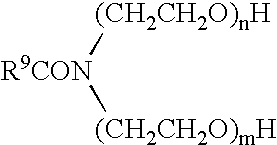Conductive lubricant composition
a technology of conductive lubricant and composition, applied in the direction of group 5/15 element organic compounds, mechanical apparatus, organic chemistry, etc., can solve the problems of lubrication failure, damage to bearings, essential electronic parts and magnetic parts, etc., to prevent anomalous wear and generation
- Summary
- Abstract
- Description
- Claims
- Application Information
AI Technical Summary
Benefits of technology
Problems solved by technology
Method used
Image
Examples
production example 1
[0121] 2-Octyl-1-dodecanol (300 g), 1-bromooctane (300 g), tetrabutylammonium bromide (30 g), and an aqueous sodium hydroxide solution (500 g) (sodium hydroxide (150 g) dissolved in water (350 g)) were placed in a 2-L glass flask, and the mixture was allowed to react under stirring for 20 hours at 50° C.
[0122] After completion of reaction, the reaction mixture was transferred to a separating funnel, and the aqueous layer was separated through filtration. The remaining organic layer was washed five times with water (500 mL).
[0123] The organic layer was distilled under reduced pressure, to thereby separate an ether compound having the following structure.
production example 2
[0124] 2-Hexyl-1-decanol (300 g), 1-bromodecane (300 g), tetrabutylammonium bromide (30 g), and a 30% aqueous sodium hydroxide solution (500 g) (sodium hydroxide (150 g) dissolved in water (350 g)) were placed in a 2-L glass flask, and the mixture was allowed to react under stirring for 20 hours at 50° C.
[0125] After completion of reaction, the reaction mixture was transferred to a separating funnel, and the aqueous layer was separated through filtration. The remaining organic layer was washed five times with water (500 mL).
[0126] The organic layer was distilled under reduced pressure, to thereby separate an ether compound having the following structure.
production example 3
[0127] 2-Octyl-1-dodecanol (300 g), 1-bromodecane (300 g), tetrabutylammonium bromide (30 g), and a 30% aqueous sodium hydroxide solution (500 g) (sodium hydroxide (150 g) dissolved in water (350 g)) were placed in a 2-L glass flask, and the mixture was allowed to react under stirring for 20 hours at 50° C.
[0128] After completion of reaction, the reaction mixture was transferred to a separating funnel, and the aqueous layer was separated through filtration. The remaining organic layer was washed five times with water (500 mL).
[0129] The organic layer was distilled under reduced pressure, to thereby separate an ether compound having the following structure.
4. Base oils and additives
[0130] Base oils and additives employed in the following Examples and Comparative Examples are listed in Tables 1 and 2.
TABLE 1Base oilCompoundsBase oil A-1Compound synthesized in Production Example 1Base oil A-2Compound synthesized in Production Example 2Base oil A-3Compound synthesized in Product...
PUM
| Property | Measurement | Unit |
|---|---|---|
| volume resistivity | aaaaa | aaaaa |
| kinematic viscosity | aaaaa | aaaaa |
| viscosity index | aaaaa | aaaaa |
Abstract
Description
Claims
Application Information
 Login to View More
Login to View More - R&D
- Intellectual Property
- Life Sciences
- Materials
- Tech Scout
- Unparalleled Data Quality
- Higher Quality Content
- 60% Fewer Hallucinations
Browse by: Latest US Patents, China's latest patents, Technical Efficacy Thesaurus, Application Domain, Technology Topic, Popular Technical Reports.
© 2025 PatSnap. All rights reserved.Legal|Privacy policy|Modern Slavery Act Transparency Statement|Sitemap|About US| Contact US: help@patsnap.com



